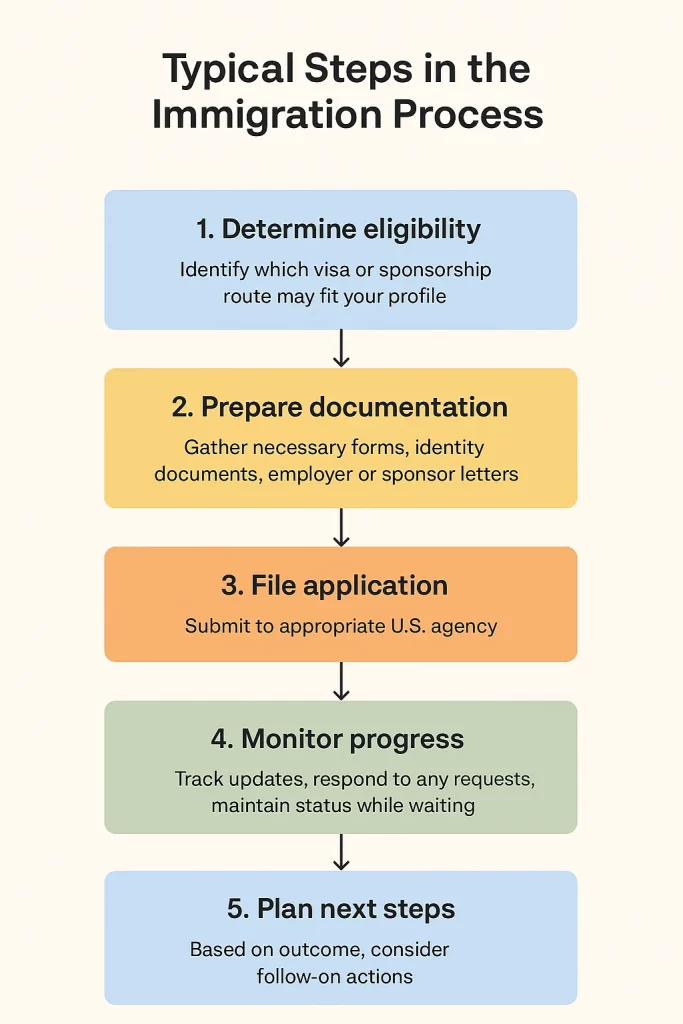For Indian Nationals Considering a Move to the United States
Many professionals and families from India explore opportunities in the United States—whether for work, education, entrepreneurship, or family reunification. The immigration system involves multiple paths and rules, which vary based on visa category and personal circumstances. Working with an Experienced Immigration Lawyer for Indian Nationals may help you better understand available options and avoid common paperwork mistakes.
The process can be overwhelming—numerous forms, strict timelines, and evolving regulations. This article offers a practical, step-by-step overview designed especially for Indian nationals planning to live, work, or build a future in the U.S.
✦ Common Immigration Paths for Indian Nationals
1. Employment-Based Options (H-1B, PERM, EB visas)
Many Indian professionals first arrive on a temporary work visa, such as the H-1B specialty occupation visa, and later explore permanent residence (Green Card). Typical steps may include:
| Path | Who Usually Uses It | Notes |
|---|---|---|
| H-1B Specialty Occupation Visa | Technology, engineering, finance, healthcare | Annual lottery; employer sponsorship required |
| PERM Labor Certification | Employees on H-1B seeking permanent residence | Multi-step review process |
| EB-1 / EB-2 / EB-3 | Researchers, executives, professionals with advanced degrees | May require evidence of qualifications or sponsorship |
Because certain employment-based categories have longer wait times for individuals born in India, some people choose optional routes like EB-1 (extraordinary ability) or National Interest Waiver (NIW) when eligible.

2. Business or Investment-Based Options
Indian entrepreneurs interested in business expansion or investment sometimes explore:
- E-2 Investor Visa (available when routed through a treaty country)
- L-1 Intracompany Transfer Visa (for executives or managers of multinational companies)
These pathways may require careful documentation to demonstrate business plans, investment sources, or managerial authority.
3. Family-Based Immigration
Common scenarios include:
- Marriage to a U.S. citizen
- Sponsorship by a spouse, parent, or adult child who is a U.S. citizen or Green Card holder
Processing steps may vary depending on where the applicant currently lives and whether adjustment of status or consular processing applies.
4. Education and Student Path
Many students from India pursue U.S. education through the F-1 student visa. After graduation, some apply for:
- OPT (Optional Practical Training)
- STEM OPT extension
- Employment-based visas sponsored by employers
For some, education becomes the first step in building long-term residency plans.
✦ Why Many Indian Nationals Consult Lawyers
U.S. immigration rules involve:
- Changing regulations
- Strict filing deadlines
- Large volumes of supporting documentation
Mistakes—even small errors—may result in delays or requests for additional evidence. Someone choosing to consult an Experienced Immigration Lawyer for Indian Nationals might pursue:
- A clearer understanding of which visa fits their goal
- Help organizing documentation
- A strategy based on eligibility and timeline planning
This does not guarantee results, but may reduce uncertainty and confusion during the application process.
✦ How the Process Typically Works
A legal guidance process may include:
- Understanding your goals
- Identifying possible options (employment-based / family / business)
- Reviewing eligibility and required documentation
- Preparing forms and evidence
- Monitoring submission and follow-ups

Each case is unique. Immigration timelines can vary significantly depending on visa type and government processing speed.
✦ Documentation Indian Nationals Commonly Prepare
- Passports & I-94 travel history
- Education credentials (transcripts, evaluations)
- Tax documents / employment history
- Relationship evidence (for family-based petitions)
Some applicants also need police clearance certificates or birth certificates reflecting certain formatting requirements.
✦ A Note About Wait Times
Certain U.S. immigration categories have longer wait times for individuals born in India. While this can be frustrating, applicants often improve their strategy by exploring alternative categories (such as EB-1 or NIW), when eligibility exists.
Again, legal guidance may help clarify options, not guarantee outcomes.
✦ Taking the Next Step
If you’re exploring U.S. immigration and would like to understand your options, you may consider connecting with an Experienced Immigration Lawyer for Indian Nationals. A lawyer can help you:
- Understand your eligibility
- Organize documentation efficiently
- Explore alternative visa categories
👉 Discover your possible U.S. immigration options. Learn More.
🔗 Useful U.S. Government Resources (Official Websites)
| Topic | Official Govt. Link |
|---|---|
| Visa types, green cards, forms, processing | https://www.uscis.gov/ |
| Visa appointment & consular processing | https://travel.state.gov/ |
| Case status check (USCIS) | https://egov.uscis.gov/casestatus/landing.do |
| I-94 travel history & record | https://i94.cbp.dhs.gov/ |
| PERM / Employment certification | https://www.dol.gov/agencies/eta/foreign-labor |






